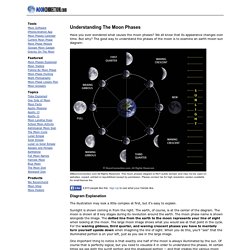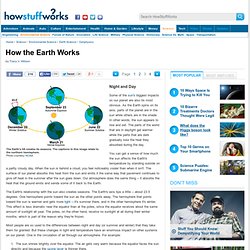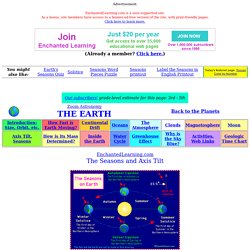

Moon Phases / Lunar Phases Explained. Have you ever wondered what causes the moon phases?

We all know that its appearance changes over time. But why? The good way to understand the phases of the moon is to examine an earth-moon-sun diagram: ©MoonConnection.com All Rights Reserved. This moon phases diagram is NOT public domain and may not be used on websites, copied, printed or republished except by permission. Diagram Explanation The illustration may look a little complex at first, but it's easy to explain. Sunlight is shown coming in from the right. One important thing to notice is that exactly one half of the moon is always illuminated by the sun. What Causes Seasons? The four seasons vary significantly in characteristics, and can prompt changes in the world around them.Credit: Shelli Jensen | Shutterstock The passing of a year can bring a marked change in the weather and the surrounding environment.

The four seasons — winter, spring, summer, autumn — can vary significantly in characteristics, and can prompt changes in the world around them. Let's take an overview of these four separate periods. HowStuffWorks "Night and Day" Some of the sun's biggest impacts on our planet are also its most obvious.

As the Earth spins on its axis, parts of the planet are in the sun while others are in the shade. In other words, the sun appears to rise and set. The parts of the world that are in daylight get warmer while the parts that are dark gradually lose the heat they absorbed during the day. You can get a sense of how much the sun affects the Earth's temperature by standing outside on a partly cloudy day. When the sun is behind a cloud, you feel noticeably cooler than when it isn't. The Earth's relationship with the sun also creates seasons. Most people are so used to the differences between night and day (or summer and winter) that they take them for granted. The sun shines brightly over the equator. This is just one piece of how the sun circulates air around the world -- ocean currents, weather patterns and other factors also play a part.
EARTH'S Seasons - Zoom Astronomy. Advertisement.

EnchantedLearning.com is a user-supported site. As a bonus, site members have access to a banner-ad-free version of the site, with print-friendly pages.Click here to learn more. (Already a member? Click here.) EnchantedLearning.comThe Seasons and Axis Tilt. HowStuffWorks "Night and Day" Big ocean currents. PROFESSOR KEITH HUNTER There are lots of currents in the ocean but there are some big ones that are responsible for the main behaviour of the ocean, and one of them is the current we call the North Atlantic Current, which is formed in the Norwegian Sea, in the north of the Atlantic Ocean.

And that current is formed by cooling down of seawater, and when you cool seawater down, it becomes heavier - if you cool anything down, it becomes heavier, and when it becomes heavier the force of gravity becomes more important, and so the cold water begins to sink down and it forms a river. The ocean around New Zealand. DR PHIL SUTTONNew Zealand is in a very interesting part of the world as far as most oceanography is concerned, but we span two ocean current regimes.

The north of New Zealand, north of Chatham Rise, basically, or north of a line between Banks Peninsula and Chatham Islands, is all in subtropical water, which is relatively warm and salty water, and then south of Chatham Rise, you get into subantarctic water, which is relatively cold and fresh. Subtropical water is connected to a big current system that flows anticlockwise around the South Pacific all the way across to South America and then westward south of the equator, southward along the coast of Australia, and then ultimately along the north-east coast of New Zealand and then a general eastward trend at about 40° south. The subantarctic system is associated with the Antarctic Circumpolar Current, which is a strong current that flows eastward all the way around Antarctica, driven by the strong winds at those latitudes.
The ocean and Earth’s systems and cycles.